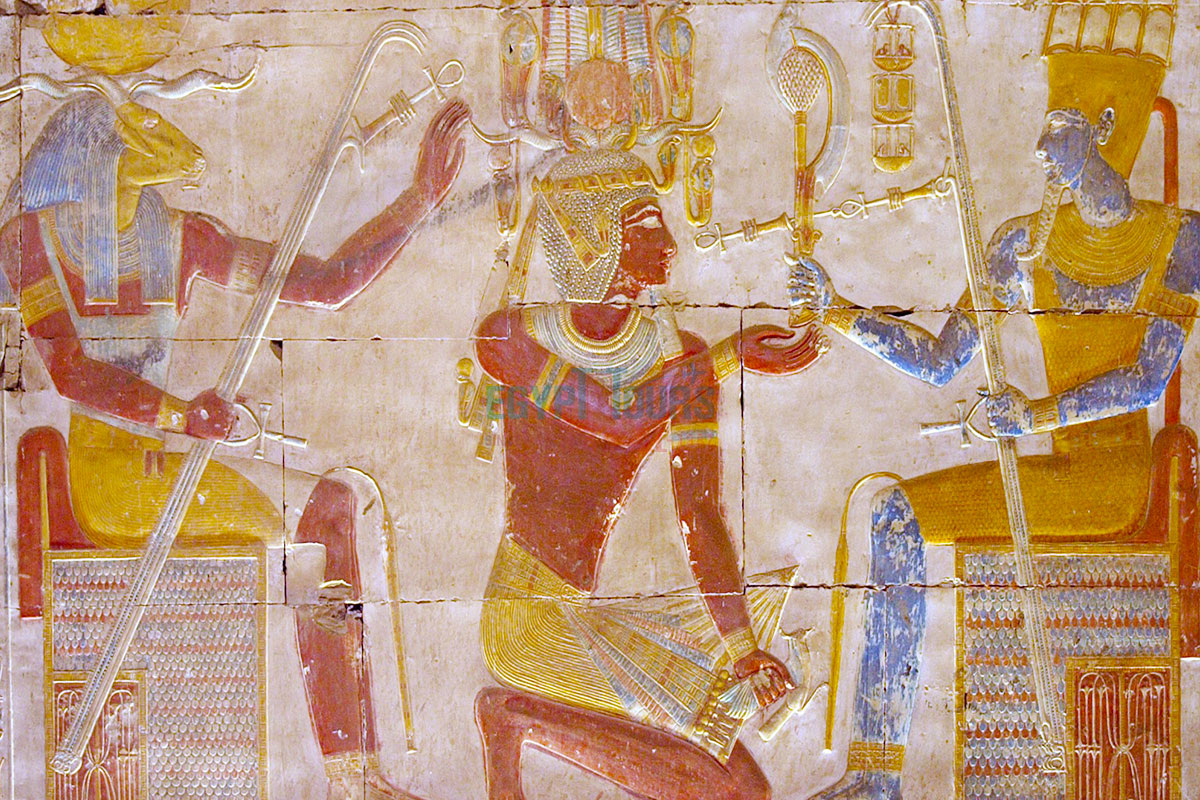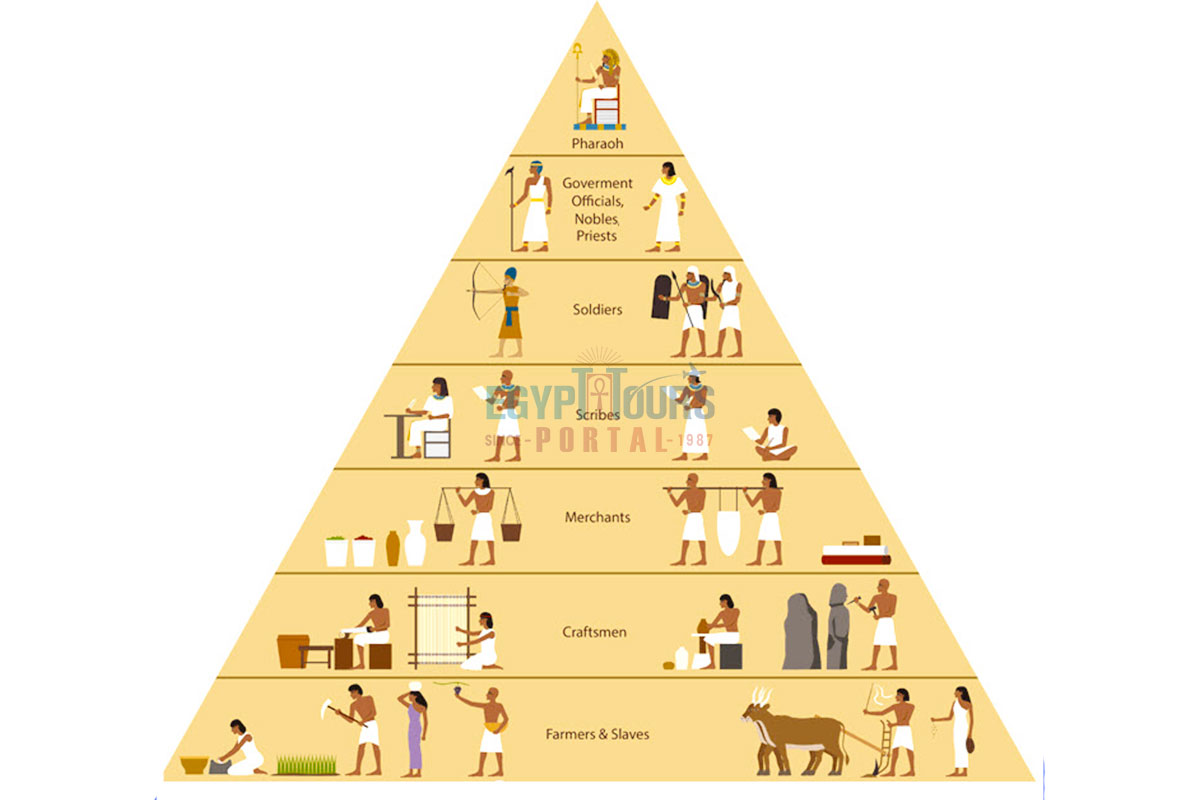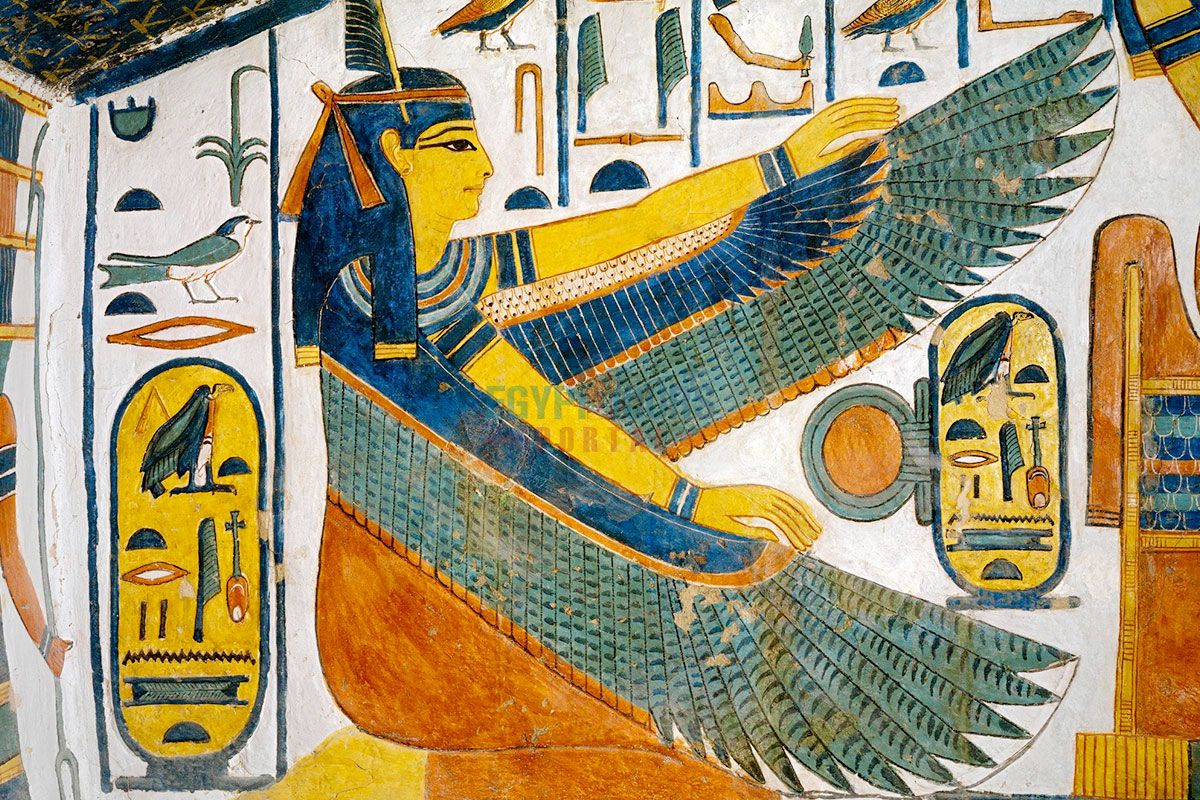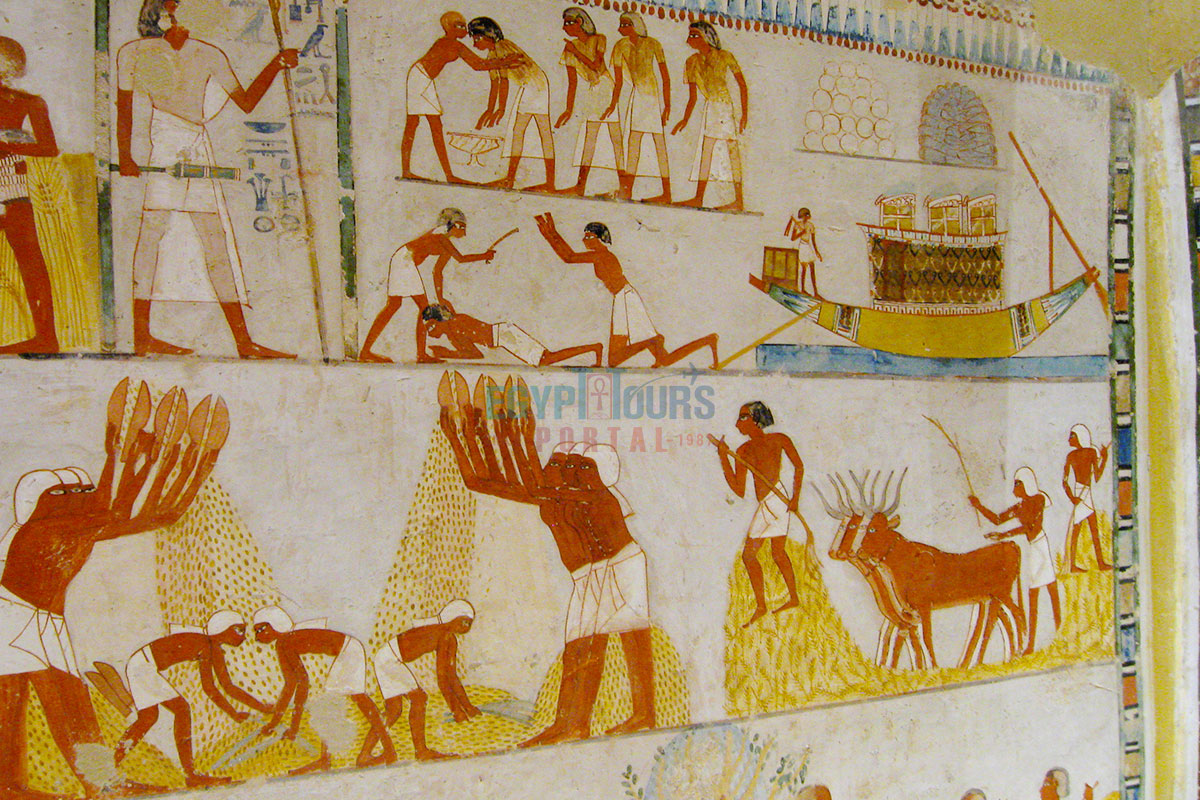Delve into the intricate social structure of ancient Egypt, shaped by its rigid hierarchy and deeply rooted religious principles, which together upheld and guided the civilization through over 3,000 years of remarkable stability, cultural richness, and enduring prosperity.

The Ancient Egyptian social structure was one of the most intricate and enduring systems in human history, sustaining a civilization that flourished for over three millennia. The ancient Egyptian society centralized around the fertile Nile Valley, this stratified society functioned as a well-oiled machine, with each tier of its hierarchy contributing to collective prosperity.
The ancient Egyptian social pyramid, deeply rooted in the principles of Ancient Egyptian Religion, governance, and geography, was deeply organized to maintain harmony and balance as dictated by the principle of Ma’at. This article explores how the complex social hierarchy in Ancient Egypt came to be and functioned, its evolution through time, the pivotal roles played by each social class, and its demise.

The Ancient Egyptian social pyramid was both a practical and ideological system designed to ensure societal stability and efficient resource management. This hierarchy, rooted in divine authority, was seen as the natural order of life, mandated by the Egyptian Gods. At the top of this structure was the pharaoh, believed to be a living deity. Beneath him, each class played a specialized role, whether in administration, religion, or labor.
Unlike contemporary societies with opportunities for social mobility, the social pyramid of Egypt along the Nile was relatively rigid for most of its history. A person’s status was often inherited at birth, aligning with the belief that this structure mirrored the cosmic order. However, certain professions like scribes or soldiers allowed for upward mobility through skill, dedication, and royal favor.
This rigid yet functional system was pivotal in maintaining Egypt's dominance over the centuries. The Ancient Egyptian social structure made sure that the Nile Valley was uniquely organized to harness the region’s resources. The predictable flooding of the Nile created a surplus of crops, enabling the growth of specialized professions and monumental building projects. Temples acted as hubs of both spiritual and economic activity, blending governance with religious practices.
Explore more fascinating details about the daily routines, beliefs, and traditions of the Egyptians.
Read More
To protect themselves from environmental challenges, wild animals, and rival tribes, people organized into tribes, relying heavily on personal gods for protection. Their belief system evolved to explain natural forces they couldn’t understand, such as storms and droughts. These beliefs manifested in three key forms:
These spiritual forces were given characteristics of humans into gods and goddesses, forming the basis of ancient Egyptian religion. These deities were seen as creators of the world, establishing everything on principles of balance and harmony, embodied by Ma’at and sustained by heka (magic).
The belief in divine harmony gave rise to Egypt’s hierarchical social structure, where everyone knew their place and responsibilities. Lower classes supported the upper classes by providing resources, while the nobility ensured the welfare of those beneath them through jobs and resource distribution. This mutual dependency upheld the societal order, aligning with the gods’ will and ensuring the success and stability of the civilization.

The principle of Ma’at was the foundation of Ancient Egyptian Civilization, symbolizing truth, balance, and justice as the guiding force of the universe and society. Established by the gods at creation, Ma’at governed all aspects of life, from personal morality to state administration, ensuring harmony and cosmic stability. The Pharaoh was seen as the living embodiment of Ma’at, and upheld its ideals by maintaining justice, securing borders, overseeing laws, and regulating natural cycles like the Nile’s flooding.
The social pyramid of Egypt along the Nile reflected this divine order, with each class fulfilling a specific role: priests upheld rituals, nobles managed resources, scribes ensured accountability, and farmers and laborers sustained the economy. Ma’at also shaped personal behavior, with individuals judged in the afterlife based on their adherence to its principles.
This collective alignment fostered unity and purpose, though deviations from Ma’at such as corruption or injustice led to societal unrest and weakened dynasties. Extending beyond Egypt’s borders, Ma’at influenced diplomacy and trade, contributing to the civilization’s millennia-long stability and success as a harmonious and enduring society.

The Ancient Egyptian Pharaohs held absolute power as both political leaders and religious figures. They were seen as living gods, embodying divine will and acting as intermediaries between the mortal and divine realms. The pharaoh was responsible for maintaining Ma’at, the cosmic order, which required ensuring justice, stability, and prosperity across the kingdom.
Pharaohs like Djoser (c. 2670 BCE) and Ramesses II (1279–1213 BCE) left indelible marks on history through their monumental building projects, military campaigns, and religious reforms. For instance, Djoser commissioned the Step Pyramid of Saqqara, the first large stone structure in history, symbolizing his divine connection and eternal legacy. Similarly, Ramesses II’s military triumphs, like the Battle of Kadesh, and architectural achievements, such as the temples at Abu Simbel, reinforced his stature as one of Egypt’s greatest rulers.
In addition to their political duties, pharaohs acted as the high priests of every temple, ensuring that the gods received offerings and that the rituals were performed correctly. Their role as both king and deity was essential to legitimizing their authority over such a vast and diverse population.
The Ancient Egyptian nobility served as the backbone of the administrative and military apparatus. These individuals ensured the smooth functioning of the state by overseeing resource management, tax collection, and public works.
The Vizier: As the pharaoh’s closest advisor, the vizier was the second most powerful person in Egypt. This role, established during the Early Dynastic Period (c. 3150–2613 BCE), included supervising all aspects of governance, from public works to judicial matters. Viziers like Imhotep, who served Djoser, were not only administrators but also renowned architects and scholars. Imhotep is credited with designing the Step Pyramid, showcasing the intellectual and cultural contributions of this role.
Nomarchs (Regional Governors): These officials managed Egypt’s provinces, known as nomes. By the Old Kingdom (c. 2613–2181 BCE), the nomarchs held significant power, ensuring local administration and collecting taxes for the central government. However, excessive autonomy among nomarchs often led to fragmentation during periods of weak pharaonic rule.
Nobles often lived in opulent estates, enjoying privileges like access to luxury goods and elaborate burials. However, their primary responsibility was to serve the pharaoh and maintain order in their respective domains.
The priests in Ancient Egypt were custodians of the temples, which were not only religious centers but also economic powerhouses. Temples owned vast tracts of land, controlled agricultural output, and employed thousands of workers. Priests performed daily rituals to honor the gods, ensuring divine favor for the land.
By the New Kingdom (c. 1570–1069 BCE), the wealth and influence of the priesthood rivaled that of the pharaoh. High priests of powerful gods like Amun at Karnak wielded immense authority, often influencing political decisions. Entry into the priesthood required extensive training, as priests specialized in specific rituals, texts, or deities.
Temples also served as educational centers, where young priests learned mathematics, astronomy, and medicine, further contributing to Egyptian society’s intellectual achievements.
Ancient Egyptian scribes were indispensable for the administration of the state. Literacy was a rare skill, and scribes were responsible for maintaining detailed records of taxation, trade, and religious ceremonies. Their work ensured the efficient management of resources and the preservation of cultural knowledge.
Training began in temple schools, where young boys learned hieroglyphics, mathematics, and administrative procedures. By the Middle Kingdom (c. 2040–1782 BCE), scribes held influential positions, often rising to ranks within the priesthood or bureaucracy. The Satire of the Trades, an ancient text, humorously highlights the prestige of scribes compared to other professions, reflecting their elevated status in society.
The Ancient Egyptian craftsmen were responsible for the cultural and architectural grandeur of Egypt. From jewelry and pottery to monumental sculptures and temples, their work symbolized the kingdom’s prosperity and artistic excellence.
Despite their critical contributions, artisans lived modest lives in government-controlled settlements like Deir el-Medina. This village housed the workers who built the tombs in the Valley of the Kings, including the magnificent tomb of Tutankhamun (c. 1332–1323 BCE). These craftsmen were often paid in grain, beer, and other goods, reflecting the barter-based economy of Ancient Egypt.
Farmers in Ancient Egypt were the lifeblood of the economy, producing crops that sustained the population and funded the state. They relied on the annual flooding of the Nile, which deposited fertile silt along its banks, to grow wheat, barley, and flax.
Slaves were often prisoners of war or debtors, and performed arduous labor in mines, quarries, and construction projects. Though they occupied the lowest tier of the pyramid, some slaves could earn their freedom or achieve positions of influence within households or temples.
The social classes in Ancient Egypt exemplified a highly organized society where every individual, from the pharaohs in Ancient Egyptian social structure to the slaves in Ancient Egypt, played a vital role in maintaining the civilization.
Guided by the principle of Ma’at, this hierarchy sustained Egypt’s prosperity for over 3,000 years, leaving a legacy of innovation, culture, and governance that continues to inspire the modern world. There are many incredible Egypt tours to choose from or a majestic Nile cruise that will fill every second with wonder. Live the adventure of your dreams and cherish your time in Egypt.
Private 4 Days Cairo Tour Packages for British Travelers 4 days Cairo Egypt Tour pac...
Tour Location: Cairo – Giza...
5 Days Cairo and Alexandria Tour Package For British Travelers 5 days Cairo and Alex...
Tour Location: Cairo/Giza/Alexandria...
6 Days Cairo, Luxor & Aswan Tour Package For British Travelers 6 days Cairo, Lux...
Tour Location: Cairo/Giza/Aswan/Luxor...
Amazing 7 Days Cairo and Hurghada Holiday for British Travelers 7 Days Cairo & H...
Tour Location: Cairo – Giza – Hurgh...
The social structure of ancient Egypt was a hierarchical system designed to maintain order and reflect the divine principles of Ma’at (harmony and balance). This stratified society resembled a pyramid, with each class assigned specific roles and responsibilities. At the top was the pharaoh, regarded as a living god, while most of the population, including farmers and laborers, formed the base. The structure ensured societal stability and allowed Egypt to flourish for over 3,000 years.
The correct order of the ancient Egyptian social structure, from highest to lowest, was:
The pharaoh was at the top of ancient Egypt’s social structure. As both a political and religious leader, the pharaoh was considered a living deity who acted as an intermediary between the gods and the people. Their primary role was to maintain Ma’at, ensuring justice, prosperity, and harmony throughout the kingdom.
The slaves occupied the lowest tier of the social structure. They were often prisoners of war, criminals, or individuals who had fallen into debt. Slaves performed arduous labor in quarries, mines, and construction projects but could sometimes earn their freedom or attain more favorable positions within households or temples.
Ancient Egyptian social classes were divided based on roles and responsibilities within the society, which were seen as part of the divine cosmic order. These divisions included:
The pharaoh held the most power in ancient Egypt's society. As a divine ruler, the pharaoh was believed to embody the gods' will on Earth, controlling the government, military, and religious institutions. The pharaoh maintained Ma’at by ensuring political stability, agricultural productivity, and adherence to religious traditions. Their authority was absolute, supported by the belief that they were chosen by the gods to lead.
The entire country of Egypt deserve to be explored with its every heavenly detail but there are places that must be seen before any other such as the breathtaking Hurghada's red sea, The wonders of Cairo the pyramids of Giza, the great sphinx, the Egyptian Museum, Khan El Khalili Bazaar, the wonders of Luxor like Valley of the Kings, Karnak & Hatshepsut temple and the wonders of Aswan such as Abu Simbel temples, Philea temple, Unfinished obelisk and The Wonders of Alexandria like Qaitbat Citadel, Pompey's Pillar and Alexandria Library. Read more about the best places to visit in Egypt.
If you want to apply for a Visa On Arrival that lasts for 30 days then you should be one of the eligible countries, have a valid passport with at least 6 months remaining and pay 25$ USD in cash, as for the E-Visa for 30 day you should have a valid passport for at least 8 months, complete the online application, pay the e-visa fee then print the e-visa to later be presented to the airport border guard. You could also be one of the lucky ones who can obtain a free visa for 90 days. Read more about Egypt travel visa.
Egypt has a variety of delicious cuisines but we recommend “Ful & Ta’meya (Fava Beans and Falafel)”, Mulukhiya, “Koshary”, a traditional Egyptian pasta dish, and Kebab & Kofta, the Egyptian traditional meat dish.
The best time to travel to Egypt is during the winter from September to April as the climate becomes a little tropical accompanied by a magical atmosphere of warm weather with a winter breeze. You will be notified in the week of your trip if the Climate is unsafe and if any changes have been made.
You should pack everything you could ever need in a small bag so you could move easily between your destinations.
We have been creating the finest vacations for more than 20 years around the most majestic destinations in Egypt. Our staff consists of the best operators, guides and drivers who dedicate all of their time & effort to make you have the perfect vacation. All of our tours are customized by Travel, Financial & Time consultants to fit your every possible need during your vacation. It doesn't go without saying that your safety and comfort are our main priority and all of our resources will be directed to provide the finest atmosphere until you return home.
You will feel safe in Egypt as the current atmosphere of the country is quite peaceful after the government took powerful measures like restructuring the entire tourist police to include all the important and tourist attractions in Egypt. Read more about is it safe to travel to Egypt.
Wear whatever feels right and comfortable. It is advised to wear something light and comfortable footwear like a closed-toe shoe to sustain the terrain of Egypt. Put on sun block during your time in Egypt in the summer to protect yourself from the sun.
The best activity is by far boarding a Nile Cruise between Luxor and Aswan or Vise Versa. Witness the beauty of Egypt from a hot balloon or a plane and try all the delicious Egyptian cuisines and drinks plus shopping in old Cairo. Explore the allure and wonders of the red sea in the magical city resorts of Egypt like Hurghada and many more by diving and snorkeling in the marine life or Hurghada. Behold the mesmerizing western desert by a safari trip under the heavenly Egyptian skies.
There are a lot of public holidays in Egypt too many to count either religious or nation, the most important festivals are the holy month of Ramadan which ends with Eid Al Fitr, Christmas and new years eve. Read more about festivals & publich holidays in Egypt.
Egypt is considered to be one of the most liberal Islamic countries but it has become a little bit conservative in the last couple of decades so it is advised to avoid showing your chest, shoulders or legs below the knees.
Arabic is the official language and Most Egyptians, who live in the cities, speak or understand English or at least some English words or phrases. Fewer Egyptians can speak French, Italian, Spanish, and German. Professional tour guides, who work in the tourism sector, are equipped to handle visitors who cannot speak Arabic and they will speak enough English and other languages to fulfill the needs of all our clients.
The fastest way is a car, of course, a taxi. If you are in Cairo ride a white taxi to move faster or you could board the fastest way of transportation in Egypt metro if the roads are in rush hour.
The temperature in Egypt ranges from 37c to 14 c. Summer in Egypt is somehow hot but sometimes it becomes cold at night and winter is cool and mild. The average of low temperatures vary from 9.5 °C in the wintertime to 23 °C in the summertime and the average high temperatures vary from 17 °C in the wintertime to 32 °C in the summertime. The temperature is moderate all along the coasts.
It is the home of everything a traveler might be looking for from amazing historical sites dating to more than 4000 years to enchanting city resorts & beaches. You will live the vacation you deserve as Egypt has everything you could possibly imagine.









